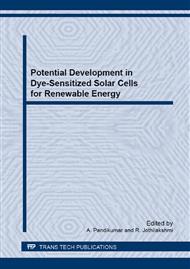p.71
p.91
p.103
p.115
p.121
p.133
p.143
p.159
p.169
RETRACTED: Enhanced Photovoltaic Performance of the Dye Sensitized Solar Cell Using Natural Dyes with Surface Modification of the Photoanode
Retracted:
The paper has been retracted upon authors' request.
The authors suspect that the results reported in the work were affected by an honest error. An attempt to reproduce the results of the work failed. The authors are not able to reproduce the microstructure of the CaCO3 coated with TiO2 and the high-resolution images of the samples created as part of this work. The authors are going to verify the characterization data i.e. XRD pattern and absorption spectra.
Abstract:
The efficiency of the best Dye sensitized solar cell is primarily depends on the good light harvesting property of the photo anode. Present study uses Lawsone (2 hydroxy [1, -naphthoquinone), the natural dye and compare the performance of photo anode in bare TiO2 and with nanoporous CaCO3 coated TiO2. As compared to bare TiO2, the surface area of nanoporous CaCO3-coated TiO2 increases, consequently, a better amount of dye adsorption occurs. The coating of CaCO3 increases the impedance at TiO2/dye/electrolyte interface and affect lifetime of the photoelectrons. Due to this reasons the short circuit current Jsc, open-circuit voltage (Voc), and fill factor (FF) increases. Thereby, the energy conversion efficiency of the solar cell is improved.
Info:
Periodical:
Pages:
159-168
Online since:
October 2013
Authors:
Keywords:
Permissions:
Share:
Citation:



